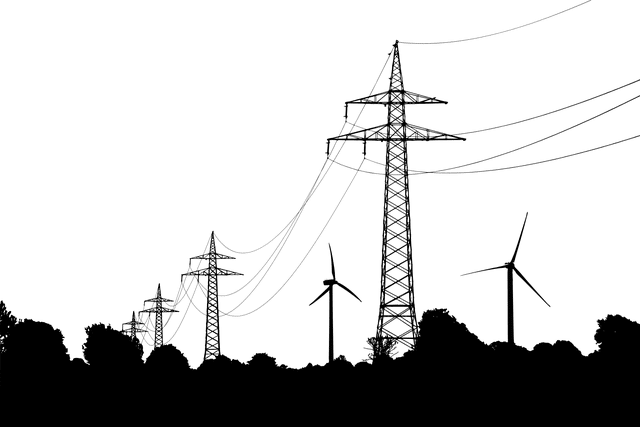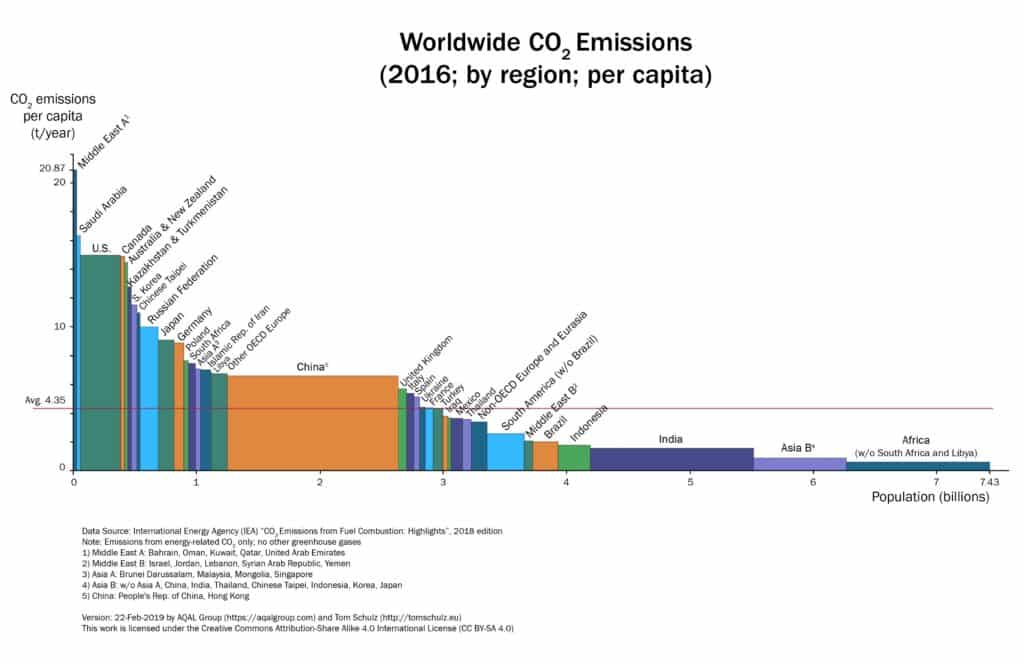Introduction – Difference Between Non-Renewable and Renewable Energy
We get a lot of excellent basic questions about carbon reduction. One of them is about the mysterious terms renewable vs non-renewable energy. We’ll dig into this concept today at ShrinkThatFootprint. Simply, renewable energy and non-renewable energy are two types of fuel sources that can be used to generate electricity. Both have their pros and cons, but if you want to live green then switching from a non-renewable energy source to a renewable one is one of the best ways to go.

Non-Renewable Energy Comes From Fossil Fuels, Such As Oil, Natural Gas, And Coal
Non-renewable energy is accessible through the use of fossil fuels, such as oil, natural gas and coal. These resources are finite and can only be extracted at a certain rate. Once they have been used up they cannot be replenished or replaced by natural processes, which means that once they are gone there will be no more left to extract.
The burning of fossil fuels releases carbon dioxide and other greenhouse gases into the atmosphere that contribute to climate change.
What about nuclear fuel? Nuclear isotopes suitable for fission are also non-renewable. Once they are used, they are expended. The big difference between nuclear fuel and fossil fuels is that nuclear fuel has zero carbon emissions. The process of fission, of reactions that liberate energy by combining the nuclei of atoms, is not one that releases carbon. Nuclear therefore stands out as a special case and a pretty useful resource as an energy source that doesn’t contribute to atmospheric carbon. France and Japan are two countries that have invested heavily in nuclear.
Renewable Energy Comes From Sources That Don’t Run Out
Renewable energy is a fuel source that can replace itself and never run out. Unfortunately, there are many ways to define renewable energy, but it’s best to think of it as any energy source that is replenished over time.
For example, solar power is a form of renewable energy because the sun’s rays can be harnessed (harvested) and converted into electricity for as long as the fusion fires of the sun burn.
Wind power can also be considered a form of renewable energy because the wind blows constantly and is always replenishing itself through natural processes. In fact, wind comes from pressure differentials that are in turn generated by the sun.
Geothermal energy comes from heat trapped deep inside the Earth. This type of energy is not from the Sun. Like the Sun, at some point in the far distant future, it will also be depleted. In the short term, for the next thousands of years, it’s accessible to humans fairly consistently.
An incredibly useful, almost renewable energy source is nuclear. France has bet heavily on nuclear such that 80% of their energy comes from nuclear fission plants. It has made the country relatively immune to the natural gas crunch as a result of the Russo-Ukraine war. On the other hand, maintenance problems has taken many plants offline.
Renewable Energy Uses Water, Wind And Solar Power And Have No Carbon Emissions
The main difference between renewable and non-renewable is that renewable energy sources can be reused or regenerated. This means that once you have used the fuel from a renewable source, you can use it again in a different way to produce electricity.
Solar power is one of the most well-known forms of clean, sustainable energy. It uses the sun’s rays to heat up water or other fluids so they turn into steam which then turns turbines and generates electricity. Solar panels are made from silicon which is an element found in sand on Earth’s surface and does not need to be imported from elsewhere. Solar panels can also be installed on your roof or on land near you – wherever there is direct sunlight.
Renewable energy does not produce this type of pollution because it does not burn anything as it produces electricity or heat for homes or businesses powered by renewable sources such as wind turbines, solar panels and hydroelectric dams in areas where water flow is consistent enough year round to produce electricity consistently
We gloss over one fine point. Even though the energy source has no carbon emissions, the production of solar panels, or lithium batteries, requires enormous energies and in the beginning, the creation of such infrastructure generates carbon emissions.
Non-Renewable Energy Sources Are Finite And Are A Leading Contributor To Carbon Emissions
Fossil fuels are non-renewable and finite. Once we run out, they’re gone. They are also a leading contributor to carbon emissions. When fossil fuels are burned, they lead to a net release of carbon dioxide. A renewable source like wood is part of a carbon lifecycle of absorption and emission. In contrast, a non-renewable source starts with release of carbon that used to be sequestered and now with its emission after burning that carbon has been unleashed on the Earth.
Carbon Emissions Lead To Global Warming
Carbon dioxide and its related compounds like methane are known as green house gases because they have the property of permitting visible sun light wavelengths to pass through from the Sun into the atmospheric shell of the Earth, and then the property of blocking, or re-radiating back, the slightly longer heat wavelengths from escaping into space. The overall effect is a “trapping effect” of heat wavelengths and the warming of the planet.
Humans Need To Switch To Renewables To Get To A Net Negative Carbon State
It may be true that carbon leads to warming, but is the amount of carbon that humans emit having any impact? The entire planet is estimated to cycle through 90 billion tons of carbon by absorption and emission in natural processes. This is almost the net balance of carbon. There are also two additional processes – so-called terrestrial and oceanic sink processes that have the effect of net absorption of carbon that add up to about 5.9 billion tons of carbon absorbed. Over time, without humans, the net-zero ocean cycle plus the two sinks means that global carbon will decrease in the atmosphere.
But what about human processes? Well, the burning of fossil fuels contributes 9.4 billion tons of carbon, which comes out to about 4.3 tons per person. That’s right, each one of us generates that much carbon dioxide per year through our energy use, consumption of food and purchasing of products. In fact, it’s not so evenly distributed. Americans emit 15 tons per person, the Chinese 7.5 tons per person, and the rest of the world less than 4 tons per person.

This emission isn’t all consumption. Our productive activities like manufacturing and agriculture all use energy and therefore all are sources of emissions.
Green Living Involves Switching To Renewable Energy Sources
Green living is about much more than just recycling. It’s also about making smart energy choices, and finding ways to reduce your carbon footprint.
Reduce the amount of waste you produce by making changes in your home and lifestyle. Switching to green energy sources can make a huge difference in the environment, especially if you’re currently using fossil fuels for heating and electricity. For example, solar power produces no emissions or other harmful substances that negatively impact our planet.
You can also make eco-friendly lifestyle changes by purchasing products made with recycled materials like bamboo flooring or wool carpet instead of regular plastic flooring or synthetic fibers like nylon carpeting which are made from non-renewable resources such as petroleum products (oil).
Recycle what you can’t reuse instead of throwing it out into landfills where it just sits there taking up space while generating greenhouse gases as it decomposes.
Switch To Renewable Energy TO Reduce Our Planetary Carbon Footprint
If you want to live green, then switching to renewable energy will help as we try to reduce our carbon footprint on our planet. Renewable energy is better for the environment than non-renewable forms of energy because it doesn’t cause pollution or contribute to global warming. It is also more sustainable because it can be replenished faster than it’s consumed by humans or industry.
Renewable sources are often more efficient in terms of cost and output when compared with non-renewable sources such as coal and oil. This means that they create less waste since they don’t produce as much carbon dioxide during production or use, which also improves air quality! Finally, renewable sources can be used in homes as well as industry which makes them easier for consumers who want an eco-friendly lifestyle while still getting all their needs met without compromising quality!
Conclusion
The answer is clear. Renewable energy sources are the future of our planet, and it’s time that we make a switch. The benefits of renewable energy far outweigh those of non-renewable resources, like fossil fuels and nuclear power plants. When you’re looking for an eco-friendly source for your home or business, look no further than renewable energy!

Anne Lauer
Anna Lauer is a writer, gardener, and homesteader living in rural Wisconsin. She has written for Mother Earth News, Grit, and Hobby Farms magazines. Anna is writing a new book about growing your food for free and an ultimate guide to producing food at little to no cost. When she’s not writing or gardening, Anna enjoys spending time with her husband and two young daughters.
